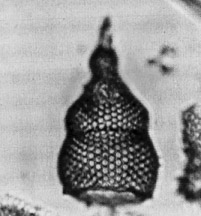 Theocorythium
vetulum Nigrini
Theocorythium
vetulum Nigrini Theocorythium
vetulum Nigrini
Theocorythium
vetulum NigriniTheocorythium vetulum Nigrini, 1971, p.447, pl.34.1, figs.6a-6b
Shell quite smooth and usually thin-walled. Cephalis trilocular, the paired lobes beneath and only slightly lateral to the larger unpaired lobe; pores small, subcircular. Stout, three-bladed apical horn, between equal to and twice the cephalic length. Primary lateral and dorsal spines continue as ribs in the thoracic wall for about half its length, but have not been observed to project externally.
Thorax cupola-shaped with circular to subcircular pores arranged longitudinally, 7-10 in a vertical series, 12-15 on a half-equator. Pronounced lumbar stricture.
Abdomen inflated conical. Pores similar in size, shape and arrangement to those of thorax, 5-12 in a vertical series, 12-17 on a half-equator. Distally, a row of three-bladed subterminal teeth is usually present. Slight terminal constriction to termination at a poreless peristome and up to eleven triangular terminal teeth, which may or may not be well-developed (Nigrini, 1971).
Based on 20 specimens. Total length (excluding apical horn and terminal teeth) 137-182 µm. Length of cephalis 27-36 µm; of thorax 45-63 µm; of abdomen (excluding terminal teeth) 45-90 µm. Maximum breadth of cephalis 27-36 µm; of thorax 81-90 µm; of abdomen 90-123 µm (Nigrini, 1971).
Similar to T. trachelium, but with the abdomen inflated conical rather than subcylindrical (Riedel and Sanfilippo, 1978a).
T. vetulum is distinguished from T. trachelium dianae (Nigrini, 1967, p.77, pl.8, figs.1a-1b, pl.9, figs.1a-1b) by its more flared abdomen (abdominal breadth of T. vetulum 90-128 µm, of T. t. dianae 72-109 µm). It is distinguished from Lamprocyclas maritalis polypora Nigrini (1967, p.76, pl.7, fig.6) in that the paired cephalic lobes of Theocorythium are beneath or only slightly lateral to the unpaired lobe, whereas in Lamprocyclas they are decidedly lateral. This is not always easily recognizable, and a more obvious difference is that Theocorythium vetulum has a longer, narrower abdomen with a finer pore pattern (Sanfilippo et al., 1985).
T. vetulum is a three-segmented pterocorythid with an inflated-conical abdomen. The most variable character is the size of the abdomen, which ranges from 40-120 µm in length. This measurement may be as little as 1/3 to greater than half the total length of the specimen. The large specimens often, but not always, have large terminal and subterminal teeth. The teeth on the smaller variety may be rudimentary or absent. In the Indian Ocean ... specimens often have no peristome. When a peristome is present, it is very weak (Sanfilippo et al., 1985).
T. vetulum is not found above 40° in the North Pacific, or above 50° in the South Pacific. It is also absent between 140°W and 175°W in the Tropical Pacific. Its occurrence is rare and sporadic in late Pliocene sediments of the Indian Ocean, and it is also rare in the North Atlantic. Its morphotypic first appearance lies within the Spongaster pentas Zone and its morphotypic last appearance lies within the Pterocanium prismatium Zone.
See Phylogeny of Theocorythium trachelium trachelium herein.
Additional illustrations can be found in Sanfilippo and Riedel, 1974, pl.4, figs.6-7.